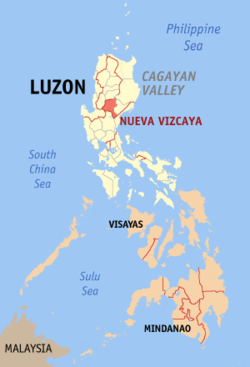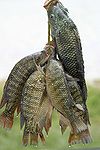- Nueva Vizcaya
-
For the province of New Spain in the Americas (now the modern Mexican states of Chihuahua and Durango), see Nueva Vizcaya, New Spain.
Nueva Vizcaya — Province — 
SealMap of the Philippines with Nueva Vizcaya highlighted Coordinates: 16°29′N 121°9′E / 16.483°N 121.15°ECoordinates: 16°29′N 121°9′E / 16.483°N 121.15°E Country  Philippines
PhilippinesRegion Cagayan Valley (Region II) Founded 1839 Capital Bayombong Government – Governor Luisa Lloren Cuaresma (Nacionalista/LDP) Area – Total 4,378.8 km2 (1,690.7 sq mi) Area rank 28th out of 80 Population (2007) – Total 397,837 – Rank 61st out of 80 – Density 90.9/km2 (235.3/sq mi) – Density rank 67th out of 80 Divisions – Independent cities 0 – Component cities 0 – Municipalities 15 – Barangays 275 – Districts Lone district of Nueva Vizcaya Time zone PHT (UTC+8) ZIP Code Spoken languages Ilocano, Tagalog, Gaddang, Isinay, Pangasinan, English Nueva Vizcaya (Filipino: Bagong Biskaya) is a province of the Philippines located in the Cagayan Valley region in Luzon. Its capital is Bayombong. It is bordered by, clockwise from the north, Ifugao, Isabela, Quirino, Aurora, Nueva Ecija, Pangasinan, and Benguet.
Contents
History, people and culture
The name was derived from the Spanish province Vizcaya in the Basque Country. The province of Nueva Vizcaya used to be a territory of the vast Cagayan Valley which was once an integral political unit with one governor. In 1839, then-Governor Luis Lardizabal issued an order transforming Nueva Vizcaya into a politico-military province upon the advice of the alcalde mayor of Cagayan. The order was approved by a Royal Decree on April 10, 1841. The province had its first taste of civil governance in 1902 when it was organized by the Philippine Commission.
The present territory of Nueva Vizcaya was the result of changes emanating from the formal creation of the province of Isabela in May 1865, wherein a great portion of its northern territory was ceded to the newly-born province. In 1908, the organization of the province of Ifugao further reduced the area of Nueva Vizcaya which was forced to give up its northwest territory. The survey executed by the Bureau of Lands in 1914 further caused the diminution of its area and reduced again upon the enactment of the Administrative Code of 1917.
In 1942, Japanese troops occupied Nueva Vizcaya. Filipino and American troops liberated the province in 1945.
In 1971, with the passage of Republic Act No. 6394, Quirino, which was then a sub-province of Nueva Vizcaya, was separated from its mother province and made into a regular province.
Since Nueva Vizcaya's birth as a province, traces of the culture and customs of its early settlers—the Ilongots (Bugkalot), Igorots, Ifugaos, Isinays, and the Gaddangs—can still be seen. The influx of civilization and the infusion of modern technology to the life stream of the province induced many immigrants from adjacent provinces to migrate to this province.
The history of organized religion in the province of Nueva Vizcaya dates back to the year 1607 when the Dominican Order arrived at the hinterlands of the province to preach their beliefs. It was not until 1609, however, that the first settlement of a religious order was established in the southern half of the province. In 1702, a covenant was erected in Burubur at the foot of the Caraballo mountains in Santa Clara, which is now a barangay of the town of Aritao. It was on this site that the first mass in Nueva Vizcaya was celebrated and the first baptism of a Christian convert was held.
Every last week of May, Nueva Vizcaya celebrates the Ammungan festival (formerly Panagyaman festival), a week-long affair culminating on May 24, the province's foundation day.
Geography
The province has a total land area of 4,378.80 square kilometers, which accounts for 16.30% of the total land area of Region II. It is composed of 15 municipalities, with Bayombong as the provincial capital and major educational center, Bambang and Solano, Nueva Vizcaya as the major commercial centers, and Kayapa as the summer capital and "vegetable bowl." Bayombong lies approximately 268 kilometers north of Metro Manila and can be reached by land via the Cagayan Valley Road (Maharlika Highway).
With forest land, agricultural areas and grasslands occupying a wide swath of the province, it does not come as a surprise that Nueva Vizcaya is an ideal site for extensive agricultural activity. Its main crops are rice, corn, vegetables, pineapple, banana, coffee, coconut, oranges and other fruit trees. The first time that an actual live photo of the worcester buttonquail was taken occurred in Nueva Vizcaya in early 2009. http://en.wikipedia.org/wiki/Luzon_Buttonquail
In mining, the province faces bright prospects. According to the Bureau of Mines and Geo-Sciences, deposits of metallic minerals which can be exploited are copper, gold, molybdenum and pyrite. Non-metallic deposits include red clay, white clay and limestone. Sand and gravel are the most abundant deposits in the province.
Politics
Nueva Vizcaya has one congressional district, although there has been a longtime proposal to divide the province into two congressional districts: "North District," comprising the northern municipalities; and "South District," composed of the southern towns.
University
Nueva Vizcaya has two Universities.
Tilapia industry
On January 11, 2008, the Cagayan Bureau of Fisheries and Aquatic Resources (BFAR) stated that tilapia (species of cichlid fishes from the tilapiine cichlid tribe) production grew and Cagayan Valley is now the Philippines’ tilapia capital (Saint Peter’s fish). Production supply grew 37.25% since 2003, with 14,000 metric tons (MT) in 2007. The recent aquaculture congress found that the growth of tilapia production was due to government interventions: provision of fast-growing species, accreditation of private hatcheries to ensure supply of quality fingerlings, establishment of demonstration farms, providing free fingerlings to newly constructed fishponds, and the dissemination of tilapia to Nueva Vizcaya (in Diadi town). Former cycling champion Lupo Alava is a multi-awarded tilapia raiser in Bagabag, Nueva Vizcaya. Chairman Thompson Lantion of the Land Transportation Franchising and Regulatory Board, a retired two-star police general, has fishponds in La Torre, Bayombong, Nueva Vizcaya. Also, Nueva Vizcaya Gov. Luisa Lloren Cuaresma also entered into similar aquaculture endeavors in addition to tilapia production.[1]
Municipalities
Nueva Vizcaya is subdivided into 15 municipalities.
References
External links
Municipalities Categories:
Wikimedia Foundation. 2010.



